Low carbon heating in domestic buildings - technical feasibility: report
A report undertaken to assess the suitability of low carbon heating technologies in residential buildings in Scotland.
4 Suitability of low carbon heating options across Scotland's housing stock
4.1 Barriers to suitability of the housing stock
This section explores the number and the types of homes in the Scottish building stock that are affected by some of the most relevant constraints to the implementation of low-carbon heating. These include space constraints, location off the gas grid, fuse limits and peak specific heat demand. In this section the number of affected homes, and an overview of their characteristics according to the main defining attributes, are reported for each of the four main constraints.
Note that the analysis reported in this section focusses on describing the extent to which a single constraint is present across the housing stock, analysing only one constraint at a time, while not accounting for the others. Conversely, the suitability of the stock to a particular low-carbon heating technology is not determined by one constraint alone, but rather by a combination of a wide set of constraints, described in section 2.2. The overall suitability of the housing stock to each of the considered low-carbon heating technologies is later discussed in Section 4.3.
4.1.1 Space constraint
In this study, homes with total dwelling floor area per habitable room smaller than 18m2 are considered space constrained. A space constraint is relevant when assessing the suitability of a dwelling to technologies that require a large amount of space for the installation of their equipment. This was assumed to be the case for all conventional, high-temperature and hybrid heat pumps, due to their additional requirement of a large hot water cylinder for the production of hot water.
Figure 3 reports the number of homes currently affected by the space constraint in 2017, as well as a breakdown of their age, property type, size, wall insulation, roof insulation and existing heating system. For comparison with the characteristics of the current entire Scottish housing stock in 2017, see Figure 1.
Energy efficiency measures aimed at improving the EPC rating of Scottish homes leading to 2040 as considered in our analysis with PEAT, were assumed to have no impact on the floor area or on the number of habitable rooms. Therefore, the relevance of the space constraint for Scotland's building stock is considered to remain unvaried over the analysed timeframe.
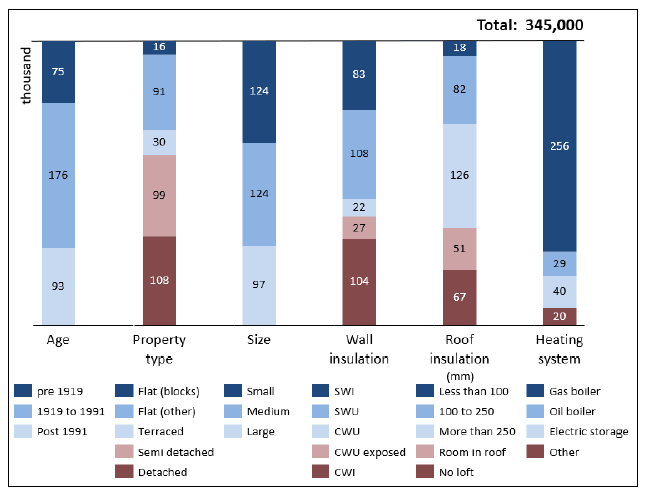
Figure description:
A vertical bar chart shows that Scotland’s housing stock in 2017 included approximately 345,000 homes affected by space-constraint, which are broken down: by age (75,000 were built pre-1919, 176,000 between 1919 to 1991 and 93,000 post 1991); by property type (16,000 are flats (blocks), 91,000 flats (other), 30,000 terraced, 99,000 semi-detached and 108,000 detached); by size (124,000 are small, 124,000 medium and 97,000 large-sized); by amount of wall insulation; by amount of roof insulation; and by heating system (256,000 have a gas boiler, 29,000 oil boiler, 40,000 electric storage heating and 20,000 other heating systems).
The number of homes affected by the space constraint results to account for about 14% of Scotland's housing stock.
The portion of homes that results show to be affected by the space constraint tends to be composed of more newer homes, compared with the overall age distribution of the Scottish dwelling stock. In fact, homes built after 1991 compose 27% of the constrained stock, as opposed to 19% of the national stock. Conversely, homes built between 1919 and 1991 account for 51% of the constrained stock, against 62% of the national figure. Finally, homes built before 1919 represent 22% of the constrained stock and 19% of the overall stock.
Space constrained homes include a smaller share of flats (-8%) and a larger share of detached houses (+10%) than the national average. Additionally, homes affected by the space constraint result to include more homes with a small floor area below 66 m2 (+10%), fewer with medium area comprised between 66 and 108 m2 (-14%) and roughly the same amount of homes with large area over 108 m2 (+3%), when compared with the national distribution. While detached houses have on average a larger floor area than flats, the number of habitable rooms in detached houses is also generally larger. These figures suggest that the proportion of total floor area and the number of habitable rooms is more likely to be smaller than 18m2 in detached houses than in flats.
Except for the above highlighted differences, the remaining attributes of the space constrained stock appear to generally match those of the national stock, suggesting that the space constraint does not affect any type of home in particular, when looking at its insulation type and existing heating system.
4.1.2 Location off the gas grid
A connection to the gas grid is fundamental for the installation of heating technologies that rely on low-carbon gas, such as hydrogen boilers, natural gas boilers with biomethane grid injection and hybrid heat pumps with natural gas. In this study it is assumed that homes located in an area on the gas grid are suitable for these technologies, regardless of whether these homes currently have a connection to the grid or not. The suitability constraint will therefore affect only homes that are located in areas away from the gas grid.
The number of homes located off the gas grid, as well as a breakdown of their age, property type, size, wall insulation, roof insulation and existing heating system are reported in Figure 4. For comparison with the characteristics of the entire Scottish housing stock, see Figure 1.
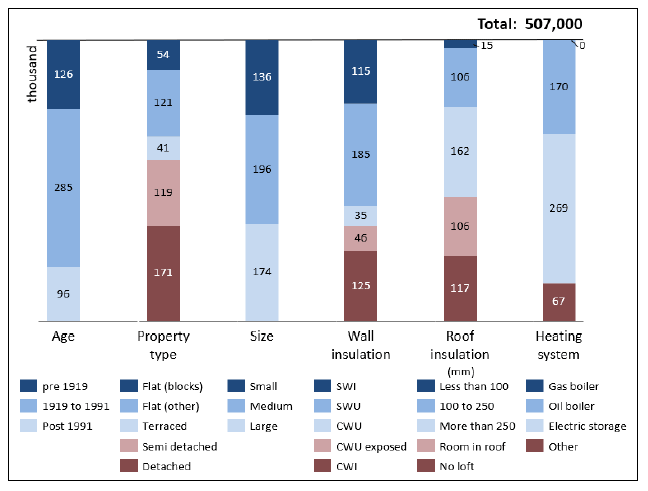
Figure description:
A vertical bar chart shows that Scotland’s housing stock in 2017 included approximately 507,000 homes off the gas grid, which are broken down: by age (126,000 were built pre-1919, 285,000 between 1919 to 1991 and 96,000 post 1991); by property type (53,000 are flats (blocks), 121,000 flats (other), 41,000 terraced, 119,000 semi-detached and 171,000 detached); by size (136,000 are small, 196,000 medium and 174,000 large-sized); by amount of wall insulation; by amount of roof insulation; and by heating system (zero have a gas boiler, 170,000 oil boilers, 269,000 electric storage heating and 67,000 other heating systems).
Homes that are located off the gas grid result to amount to about 21% of Scotland's housing stock.
Gas boilers are installed in 99% of homes located on the gas grid. Predictably, no homes with gas boilers figure in the portion of stock located off the gas grid. The distribution of the other three counterfactual heating technology categories (oil boiler, electric storage heating and other) in homes off the gas grid is therefore proportional to that of the Scottish housing stock, with a preference for electric storage heating (53%), followed by oil boilers (34%) and other heating systems (13%).
While the age distribution of the affected stock is roughly comparable with that of the Scottish stock, the property type distribution is significantly different. Homes in blocks of flats that are located off the gas grid are almost double (11%) the number of homes in blocks of flats in the national stock (6%). Additionally, more detached homes and fewer flats (other) result to be located off the gas grid than the national distribution of the property type. In fact, while homes located off the gas grid are composed of 24% of flats (other) and 34% of detached houses, the two categories respectively account for 34% and 21% of the national stock.
Additionally, this constraint impacts on more homes with a large floor area over 108 m2 (+10%) and fewer homes with medium floor area comprised between 66 and 108 m2 (-11%), than the national distribution. Finally, homes in the constrained stock are more likely to have solid walls (+10%) than the rest of the stock.
4.1.3 Fuse limit
The implementation of heating technologies that involve a large peak consumption of electrical power may be restricted by the fuse rating of the electrical connection of a home. In fact, the total current drawn by the heating device and all other domestic appliances together should never exceed the fuse limit of the electrical cut-out.
Therefore, an assessment was performed on the number and type of homes for which fuse rating would pose a restriction to the implementation of some of the most relevant low-carbon heating technologies utilising electricity: electric storage heating, direct electric heating and air source heat pumps. The limit on the implementation of each technology had to be assessed separately, due to their different types of power demand.
Additionally, due to the uncertainty of the actual fuse limit values of individual Scottish homes, this analysis was performed for three different potential fuse limit values (60A, 80A and 100A), each time assuming that all homes in the entire housing stock have the same value of fuse limit. Fuse upgrades to up to 100A, the maximum value available for a single-phase domestic connection, generally involve the replacement of the fuse alone and are associated with little to no cost, depending on the state of the connection cables and on the network operator.
The number of homes that may be affected by the fuse limit constraints for each of these technologies are reported in Figure 5, Figure 6 and Figure 7 respectively, each showing the portion of the affected stock for the considered range of fuse limit values in 2017 and 2040.
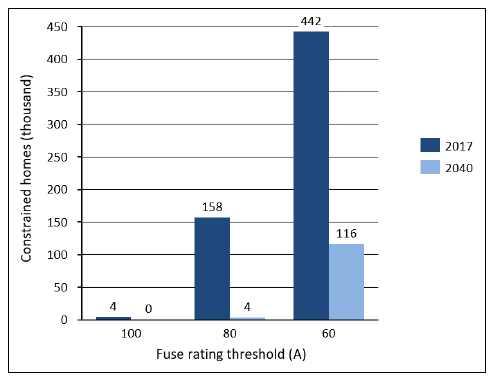
Figure description:
A bar chart shows the number of constrained homes to the installation of electric storage heating in 2017 and 2040 against the fuse rating threshold, depending on fuse limits of 100, 80 and 60 A. It is shown that there are 4,000 constrained homes in 2017 and 0 constrained homes in 2040 on a 100 A fuse limit, 158,000 homes in 2017 and 4,000 homes in 2040 on a 80 A fuse limit, and 442,000 homes in 2017 and 116,000 in 2040 on a 60 A fuse limit.
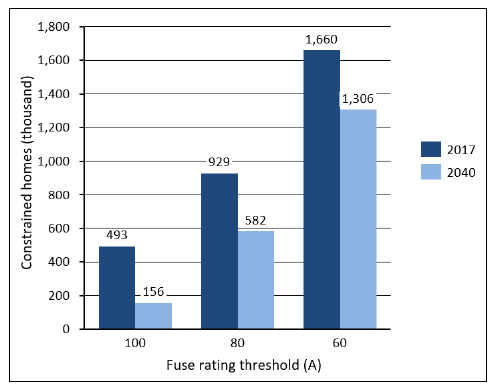
Figure description:
A bar chart shows the number of constrained homes to the installation of direct electric heating in 2017 and 2040 against the fuse rating threshold, depending on fuse limits of 100, 80 and 60 A. It is shown that there are 493,000 constrained homes in 2017 and 0 constrained homes in 2040 on a 100 A fuse limit, 158,000 homes in 2017 and 4,000 homes in 2040 on a 80 A fuse limit, and 442,000 homes in 2017 and 116,000 in 2040 on a 60 A fuse limit.
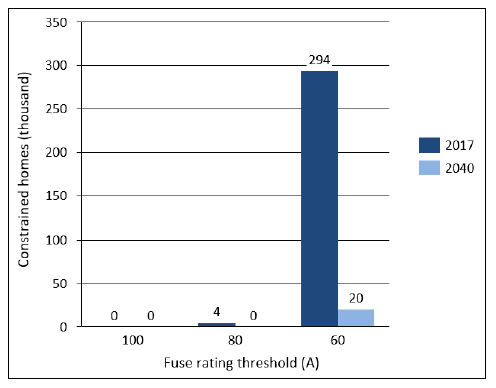
Figure description:
A vertical bar chart shows the number of constrained homes to the installation of air source heat pumps in 2017 and 2040 against the fuse rating threshold, depending on fuse limits of 100, 80 and 60 A. It is shown that there are 0 constrained homes in 2017 and 0 constrained homes in 2040 on a 100 A fuse limit, 4,000 homes in 2017 and 0 homes in 2040 on a 80 A fuse limit, and 294,000 homes in 2017 and 20,000 in 2040 on a 60 A fuse limit.
For all three technologies, low values of fuse limit result in a larger number of homes affected by the constraint, as this is equivalent to a more stringent test.
A large portion of homes are affected by the fuse limit constraint for the installation of direct electric heating compared to storage heating. While thermal efficiency is 100% for both technologies and the total electrical energy drawn is also the same, storage heating is advantaged by operating overnight, when fewer other appliances are switched on.[28] This means that storage heating can draw a higher peak power than direct electric heating and more homes with large heating demand result to be suitable for this technology.
The number of constrained homes for the installation of ASHP is significantly lower than for the two electric resistive heating technologies, due to the heat pump's efficiency being much larger than 100%. Even on the coldest days of the year, the COP is expected to be between 2 and 3, resulting in a low power consumption and in a lower number of homes restricted by fuse limit for the installation of this technology. Note however that this analysis does not consider the additional load required for domestic fast charging of an electric vehicle, which may significantly increase the number of homes restricted by fuse limits.
The number of homes affected by the fuse limit constraint is expected to decrease substantially between 2017 and 2040. Efficiency upgrade measures implemented to the building result in better insulation, lower space heating demand and thus a lower demand of power to test against the fuse limit. The number of homes constrained by fuse limit in the installation of ASHP in 2040 is well below 1% for any fuse rating.
Finally, the characteristics of homes affected by the fuse limit constraint were also investigated, assuming a fuse rating of 80A for the entire housing stock. The results for electric storage heating, direct electric heating and air source heat pumps are reported respectively in Figure 8, Figure 9 and Figure 10. The diagrams report the number of affected homes, as well as a breakdown of their age, property type, size, wall insulation, roof insulation and existing heating system. For comparison with the characteristics of the entire Scottish housing stock, see Figure 1.
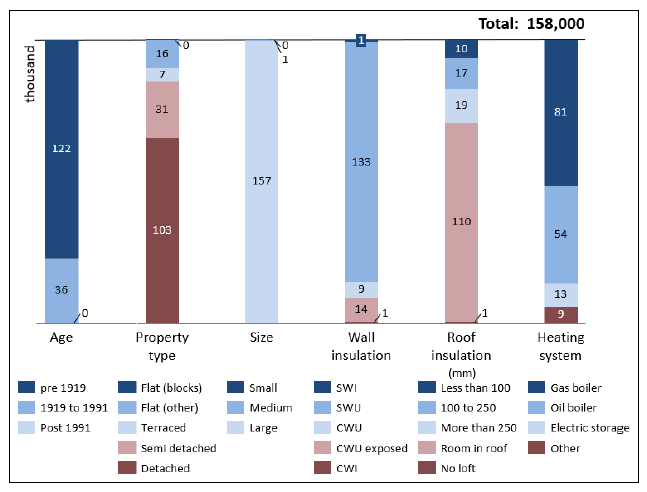
Figure description:
A bar chart shows that there are 158,000 constrained homes to the installation of electric storage heating in 2017 for a fuse limit of 80 A, which are broken down: by age (122,000 were built pre-1919 and 36,000 between 1919 to 1991) by property type (16,000 flats (other), 7,000 terraced, 31,000 semi-detached and 103,000 detached); by size (1,000 medium and 157,000 large-sized); by wall insulation (1,000 are SWI, 133,000 SWU, 9,000 CWU, 14,000 CWU exposed and 1,000 CWI); by roof insulation (10,000 have less than 100 mm, 17,000 between 100 to 250 mm, 19,000 more than 250 mm, 110,000 have a room in roof and 1,000 have no loft); and by heating system (81,000 have a gas boiler, 54,000 oil boilers, 13,000 electric storage heating and 9,000 other heating systems).
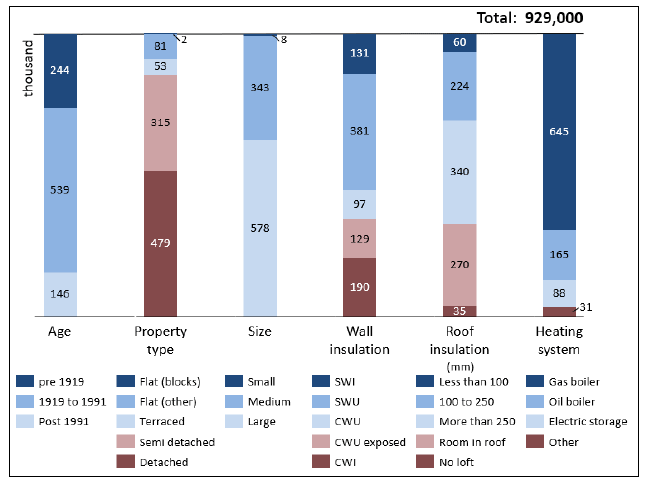
Figure description:
A bar chart shows that there are 929,000 constrained homes to the installation of direct electric heating in 2017 for a fuse limit of 80 A, which are broken down: by age (244,000 were built pre-1919, 539,000 between 1919 to 1991 and 146,000 post 1991); by property type (2,000 are flats (blocks), 81,000 are flats (blocks), 53,000 terraced, 315,000 semi-detached and 479,000 detached); by size (8,000 are small, 343,000 medium and 578,000 large-sized); by wall insulation (131,000 are SWI, 381,000 SWU, 97,000 CWU, 129,000 CWU exposed and 190,000 CWI); by roof insulation (60,000 have less than 100 mm, 224,000 between 100 to 250 mm, 340,000 more than 250 mm, 270,000 have a room in roof and 35,000 have no loft); and by heating system (645,000 have a gas boiler, 165,000 oil boilers, 88,000 electric storage heating and 31,000 other heating systems).
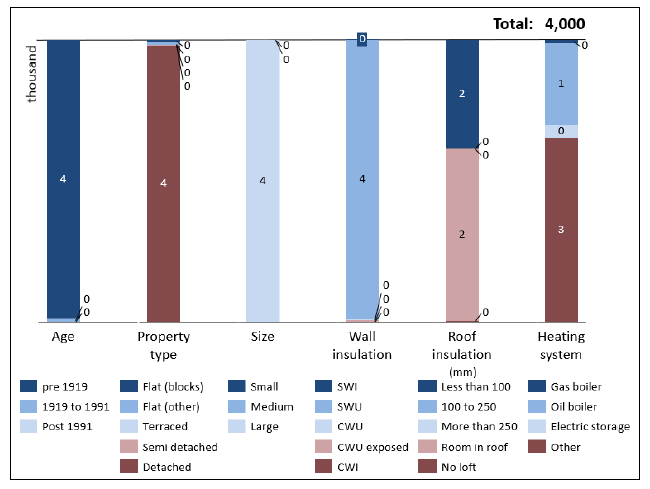
Figure description:
A bar chart shows that there are 4,000 constrained homes to the installation of air source heat pumps in 2017 for a fuse limit of 80 A, which are broken down: by age (all 4,000 were built pre-1919); by property type (all 4,000 are detached); by size (all 4,000 are large-sized); by wall insulation (all 4,000 are SWU); by roof insulation (2,000 have less than 100 mm and 2,000 have a room in roof); and by heating system (1,000 oil boilers and 3,000 other heating systems).
Dwellings that are constrained by the fuse limit for the installation of heating technologies that rely on electricity are typically those with a large peak heating demand. In fact, depending on the efficiency of the technology, a large peak heating demand is likely to result in large peak electrical consumption and a current which may exceed the fuse rating of the cut-out.
In fact, homes that are affected by the fuse limit constraint for all three technologies are predominantly older, larger in size, less insulated and are types of homes that are more exposed to the weather compared with the national distribution.
The share of older homes built before 1919 is larger among the homes affected by fuse limit for the installation of storage heating and ASHP, likely because these two technologies allow for a larger peak heating demand than direct electric heating, and older homes are generally associated a larger heat loss.
For all three technologies, the affected stock tends towards large uninsulated homes, including a large share of detached homes with large floor area over 108 m2 and mostly with uninsulated solid walls.
4.1.4 Peak specific heat demand
Peak specific heat demand, here intended as the total heat demand of a dwelling divided by the total floor area of the habitable rooms, can be an obstacle for the implementation of air-source and ground-source heat pumps.
Heat pump technologies operate with optimal performance when delivering space heating at low flow temperature of about 35-40°C, which is considerably lower than that of conventional boilers. As a consequence, emitters of comparably larger size must be installed, in order to ensure sufficient heat transfer to the rooms. For homes with a considerable specific heat demand (or, equivalently, heat loss) the maximum size of emitters that can reasonably be installed may be insufficient to ensure thermal comfort, particularly on cold winter days with the highest peak heating demand.
To obviate the problem, conventional heat pumps can technically also be operated to deliver space heating at higher temperatures up to 60-65°C, at the expenses of performance. However, according to the EU Renewable energy directive,[29] heat pumps operating with very low performance are no longer considered as renewable heating technologies. In fact, the minimum average seasonal performance factor (SPF)[30] must be higher than 2.5.
In our analysis we are assessing the number of homes that are restricted for the installation of heat pumps by too large a peak specific heat demand. This is such that thermal comfort might not always be met by the device when operating at an SPF compatible with the EU Renewable energy directive.
The heat pump emitter guidance table provided by MCS and reported in Table 8 illustrates the relation between the specific heat loss of a dwelling (column 1), space heating flow temperature (column 2), space heating SPF for both GSHP and ASHP (columns 3 and 4), and the compatible size of various types of emitters together with the appropriateness of the solution (columns 5, 6 and 7). For any value of specific heat loss up to 150W/m2, ASHPs can operate at a "renewable" SPF of 2.5 delivering heat at a flow temperature of up to 50°C. Differently, GSHPs appear to always achieve an SPF higher than 2.5 while delivering heat at flow temperatures up to 60°C. In fact, the SPF of a GSHP is generally larger than that of an ASHP operating at the same flow temperature. This is mainly due to the heat source of GSHPs (the ground) having a higher average temperature and heat capacity.
Considering the colours indicating emitter appropriateness in columns 5-7 and explained in the legend at the bottom, the installation of an ASHP operating at flow temperature of max 50°C is considered appropriate in any case for heat loss rates of up to 100 W/m2. For heat loss rates comprised between 100 W/m2 and 150 W/m2, however, there is a varying degree of risk of thermal comfort not being met by the ASHP. Finally, the installation of an ASHP in homes with specific heat loss above 150 W/m2 is not advisable.
The range of flow temperatures at which a GSHP can deliver renewable heat is sufficient to ensure thermal comfort in homes with heat loss of up to 150W/m2, but the installation of GSHP in homes with specific heat loss above 150 W/m2 is not advisable.
Based on the above considerations, the number and type of Scottish homes that may be constrained by a too large peak specific heat demand in the installation of ASHP were assessed for a range of values of specific heat loss of 100, 120 and 150 W/m2. Each threshold includes homes with a different degree of risk to thermal comfort, as classified below:
<100 W/m2 : Suitable and likely to meet thermal comfort
100 - 120 W/m2 : Suitable but some risk of not meeting thermal comfort
120 - 150 W/m2 : Suitable but high risk of not meeting thermal comfort
>150 W/m2 : Technically unsuitable
| Room specific heat loss | Heating circuit flow temperature °C | Space heating SPF | Oversize factor | |||
|---|---|---|---|---|---|---|
| GSHP | ASHP | Fan Convector / Fan-assisted Radiator | Standard Radiator | Fan Coil Unit | ||
| <30 W/m2 | 35 | 4.3 | 3.6 | 4.3 a | 6.8 b | 5.0 b |
| 40 | 4.1 | 3.4 | 3.1 a | 4.3 a | 3.5 a | |
| 45 | 3.7 | 3.0 | 2.4 a | 3.1 a | 2.6 a | |
| 50 | 3.4 | 2.7 | 2.0 a | 2.4 a | 2.1 a | |
| 55 | 3.1 | 2.4 | 1.7 a | 1.9 a | 1.7 a | |
| 60 | 2.8 | 2.1 | 1.4 b | 1.6 b | 1.5 b | |
| 30 - 50 W/m2 | 35 | 4.3 | 3.6 | 4.3 b | 6.8 b | 5.0 b |
| 40 | 4.1 | 3.4 | 3.1 a | 4.3 b | 3.5 b | |
| 45 | 3.7 | 3.0 | 2.4 a | 3.1 a | 2.6 a | |
| 50 | 3.4 | 2.7 | 2.0 a | 2.4 a | 2.1 a | |
| 55 | 3.1 | 2.4 | 1.7 a | 1.9 a | 1.7 a | |
| 60 | 2.8 | 2.1 | 1.4 b | 1.6 b | 1.5 b | |
| 50 - 80 W/m2 | 35 | 4.3 | 3.6 | 4.3 b | 6.8 b | 5.0 b |
| 40 | 4.1 | 3.4 | 3.1 a | 4.3 b | 3.5 b | |
| 45 | 3.7 | 3.0 | 2.4 a | 3.1 a | 2.6 b | |
| 50 | 3.4 | 2.7 | 2.0 a | 2.4 a | 2.1 a | |
| 55 | 3.1 | 2.4 | 1.7 a | 1.9 a | 1.7 a | |
| 60 | 2.8 | 2.1 | 1.4 b | 1.6 b | 1.5 b | |
| 80 - 100 W/m2 | 35 | 4.3 | 3.6 | 4.3 c | 6.8 c | 5.0 c |
| 40 | 4.1 | 3.4 | 3.1 b | 4.3 b | 3.5 b | |
| 45 | 3.7 | 3.0 | 2.4 a | 3.1 b | 2.6 b | |
| 50 | 3.4 | 2.7 | 2.0 a | 2.4 a | 2.1 a | |
| 55 | 3.1 | 2.4 | 1.7 a | 1.9 a | 1.7 a | |
| 60 | 2.8 | 2.1 | 1.4 b | 1.6 b | 1.5 b | |
| 100 - 120 W/m2 | 35 | 4.3 | 3.6 | 4.3 c | 6.8 c | 5.0 c |
| 40 | 4.1 | 3.4 | 3.1 b | 4.3 c | 3.5 c | |
| 45 | 3.7 | 3.0 | 2.4 a | 3.1 b | 2.6 c | |
| 50 | 3.4 | 2.7 | 2.0 a | 2.4 a | 2.1 b | |
| 55 | 3.1 | 2.4 | 1.7 a | 1.9 a | 1.7 a | |
| 60 | 2.8 | 2.1 | 1.4 b | 1.6 b | 1.5 b | |
| 120 -150 W/m2 | 35 | 4.3 | 3.6 | 4.3 c | 6.8 c | 5.0 c |
| 40 | 4.1 | 3.4 | 3.1 c | 4.3 c | 3.5 c | |
| 45 | 3.7 | 3.0 | 2.4 b | 3.1 c | 2.6 c | |
| 50 | 3.4 | 2.7 | 2.0 a | 2.4 b | 2.1 c | |
| 55 | 3.1 | 2.4 | 1.7 a | 1.9 a | 1.7 b | |
| 60 | 2.8 | 2.1 | 1.4 b | 1.6 b | 1.5 b | |
Legend:
(a) Go ahead - System can perform at the stated efficiencies with the selected emitter design.
(b) Caution - System can perform at these design conditions with extra consideration on the emitter and heat pump design
(c) Reduce fabric and ventilation heat loss - System can perform at these design conditions but emitter sizes are likely to be excessive
The number of homes that may be affected by the peak specific heat demand constraint in the installation of an ASHP is reported in Figure 11, showing the portion of the affected stock for the considered range of specific heat loss values in 2017 and 2040.
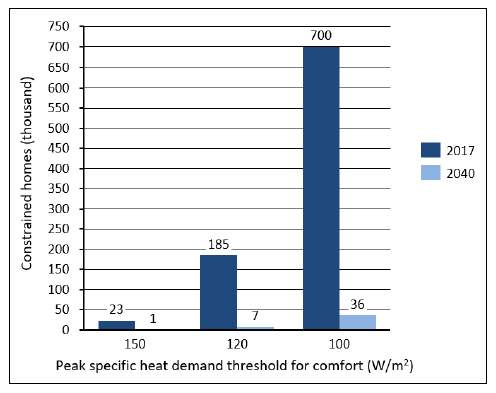
Figure description:
A bar chart shows the number of constrained homes to the installation of air source heat pumps in 2017 and 2040 against three peak specific heat demand thresholds of 150 W/m2, 120 W/m2 and 100 A. It is shown that there are 23,000 constrained homes in 2017 and 1,000 constrained homes in 2040 for a 150 W/m2 peak demand, 185,000 homes in 2017 and 7,000 homes in 2040 for a 120 W/m2 peak demand, and 700,000 homes in 2017 and 36,000 in 2040 for a 100 W/m2 peak demand.
The number of homes that are constrained by peak specific heat demand for the installation of ASHP is significantly larger than the number of homes constrained by the fuse limit constraint for the installation same technology. Additionally, the two constraint groups overlap significantly for ASHP, as almost all homes that are constrained by fuse limit are also constrained by peak specific heat demand.[32]
Additionally, the characteristics of the affected homes were more closely investigated, considering the portion of the stock with peak specific heat demand of 120 W/m2 or below. The results are shown in Figure 12 and Figure 13 for 2017 and 2040 respectively and report the number of affected homes, as well as a breakdown of their age, property type, size, wall insulation, roof insulation and existing heating system. For comparison with the characteristics of the entire Scottish housing stock, see Figure 1.
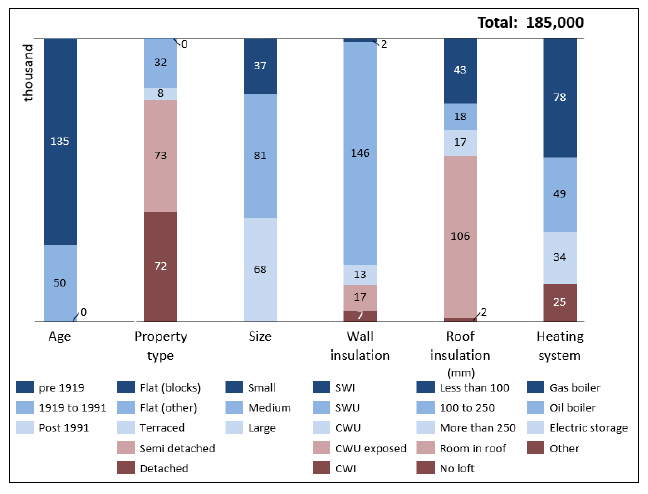
Figure description:
A bar chart shows that there are 185,000 constrained homes to the installation of air source heat pumps in 2017 for peak specific heat demand threshold of 120 W/m2, which are broken down: by age (135,000 were built pre-1919 and 50,000 between 1919 to 1991); by property type (32,000 flats (other), 8,000 terraced, 73,000 semi-detached and 72,000 detached); by size (37,000 are small, 81,000 medium and 68,000 large-sized); by wall insulation (2,000 are SWI, 146,000 SWU, 13,000 CWU, 17,000 CWU exposed and 7,000 CWI); by roof insulation (43,000 have less than 100 mm, 18,000 between 100 to 250 mm, 17,000 more than 250 mm, 106,000 have a room in roof and 2,000 have no loft); and by heating system (78,000 have a gas boiler, 49,000 oil boilers, 34,000 electric storage heating and 25,000 other heating systems).
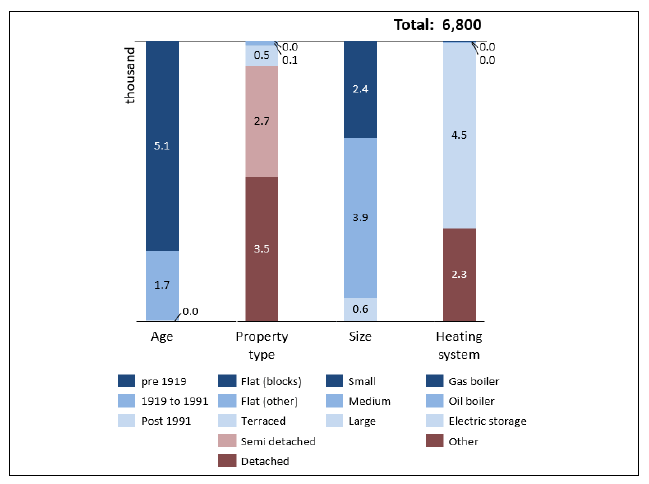
Figure description:
A bar chart shows that there will be 6,800 constrained homes to the installation of air source heat pumps in 2040 for peak specific heat demand threshold of 120 W/m2, which are broken down: by age (5,100 were built pre-1919 and 1,700 between 1919 to 1991); by property type (100 flats (other), 500 terraced, 2,700 semi-detached and 3,500 detached); by size (2,400 are small, 3,900 medium and 600 large-sized); and by heating system (4,500 electric storage heating and 2,300 other heating systems).
In the case of homes affected by the peak specific heat demand constraint, the share of older homes built before 1919 is larger than for the national average (+54%). Additionally, more frequent is the presence of detached homes (+18%) and homes with uninsulated solid walls (+50%), describing homes with large space heating demand but without particularly larger floor area than the national average.
After the implementation of energy efficiency upgrades that will increase the EPC rating of Scottish homes to level C or above, the age category distribution of homes affected by the peak specific heat demand constraint in 2040 is roughly the same as in 2017. Affected homes in 2040 are composed of more detached houses (+13%) and fewer flats (other) (-16%) than the 2017 constrained stock. The 2040 stock also comprises more small and medium homes and fewer large homes, as well as more homes utilising heating technologies off the gas grid.
The planned efficiency upgrade measures result therefore as insufficient to reduce peak specific heat demand enough for the installation of ASHP in old, small-medium sized detached or semi-detached houses off the gas grid. These are potentially individual homes located away from urban areas.
4.2 Heritage and old homes
Listed buildings and homes in conservation areas are respectively buildings and areas categorised to be of architectural or historic interest. Planning permission may be required to make changes to the external appearance of these homes. Additionally, listed building consent may be required to make changes to both external appearance and internal fixtures of listed homes. Given the additional hurdles that could thus potentially be encountered in the installation of low-carbon heating technologies and the implementation of energy performance upgrade measures in these homes, the number of heritage dwellings in Scotland's housing stock was assessed. Additionally, old dwellings (pre 1919) were also investigated, as these buildings may often present similar issues to those of heritage buildings, according to our consultation with Historic Environment Scotland.
The impact of the peculiar characteristics and restrictions of heritage and old homes on the suitability and costs for the implementation of low-carbon heating was not assessed, due to the complexity and case-by-case nature of the barriers to retrofit, as well as the high level of simplification that would be required to perform a quantitative analysis. This approach was supported by consultation with experts at Historic Environment Scotland.
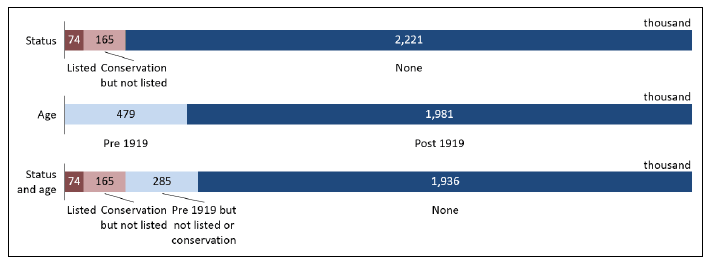
Figure description:
A horizontal bar chart shows the heritage and age status of the entire 2.46 million Scottish housing stock, which is broken down: by status (74,000 are listed, 165,000 lie in a conservation area but are not listed and 2,221,000 have no heritage status); by age (479,000 were built pre 1919 and 1,981,000 post 1919); and by both status and age (74,000 are listed, 165,000 lie in a conservation area but are not listed, 285,000 were built pre 1919 but are not listed or in a conservation area, and 1,936,000 have no heritage status).
Listed homes account for 3% of Scotland's housing stock, whereas homes that are located in conservation areas but are not listed account for an additional 7% of the stock. While roughly 19% of buildings in Scotland are reported to have been built before 1919, a significant portion of these are also included in the portion of homes that are listed or located in conservation areas. As a consequence, older homes that are neither listed nor located in conservation areas amount to 12% of the total housing stock.
The total portion of heritage and old homes in Scotland is therefore estimated to amount to about 21% of the housing stock. Given the large portion of homes that may be affected by additional requirements and restrictions in the implementation of energy performance measures and installation of low-carbon heating technologies, and given the uncertainty about the impact of these restrictions on suitability and costs, it is advisable that these parameters are further investigated.
4.3 Suitability of heating technologies
The combination of all four main constraints analysed in the previous sections, as well as additional minor constraints summarised in Table 6, was applied to the characteristics of Scotland's building stock to assess the suitability of each home for the considered low-carbon heating technologies. The results of this assessment are reported in Figure 15 and Figure 16 for the year 2017 and 2040 respectively.
The assessment was performed for three combinations of peak specific heat demand and fuse limit. The results obtained applying most stringent threshold combination (100W/m2 and 60A) refer to the stock which is in any case likely to be suitable for a specific technology. The additional portion of the stock that results from the analysis with the medium threshold combination (120W/m2 and 80A) describes the portion of the stock the suitability of which is not ruled out but may carry some risk. The additional portion of suitable stock assessed using the high threshold combination (150W/m2 and 100A) quantifies the stock which is likely suitable but with high risk of its suitability.
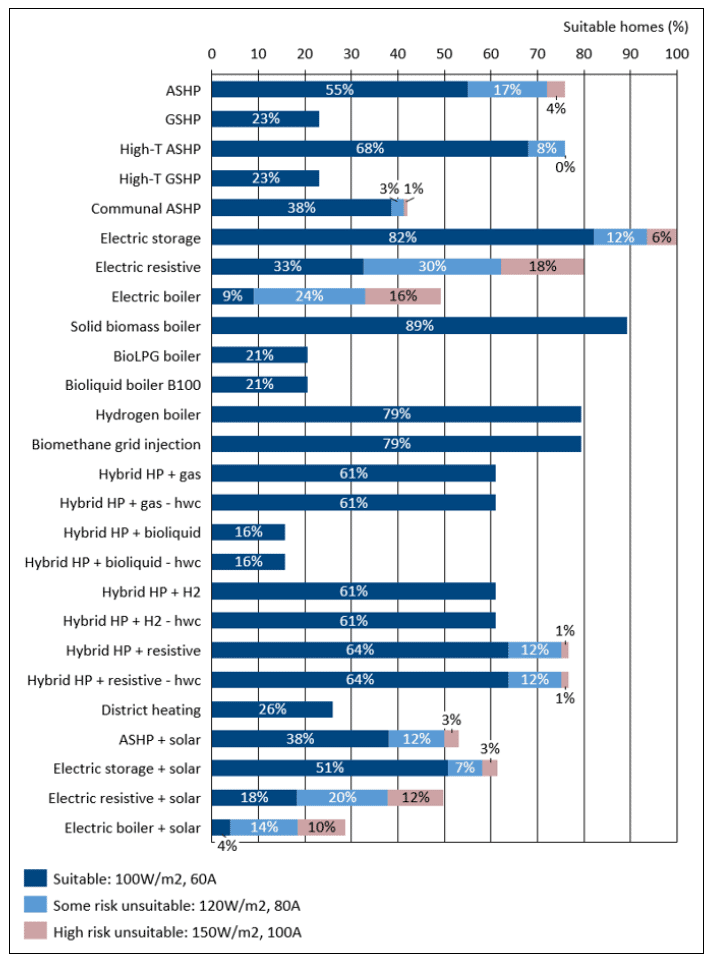
Figure description:
A horizontal bar chart shows the percentage of homes compatible with each technology under examination in 2017. The sensitivity of suitability was tested against three combinations of peak specific heat demand and fuse rating. The investigated technologies are air source and ground source heat pumps, high temperature air and ground source heat pumps, communal air source heat pumps, electric storage heating, direct electric heating, electric boiler, biomass and biofuel boilers, hydrogen boilers (both electrolysis and reforming), biomethane grid injection, hybrid heat pumps (with gas, gas and hot water cylinder, hydrogen, hydrogen and hot water cylinder, resistive heating, resistive and hot water cylinder) district heating, and heating technologies in combination with solar thermal (air source heat pump and solar, electric storage and solar, direct electric and solar and electric boiler and solar).
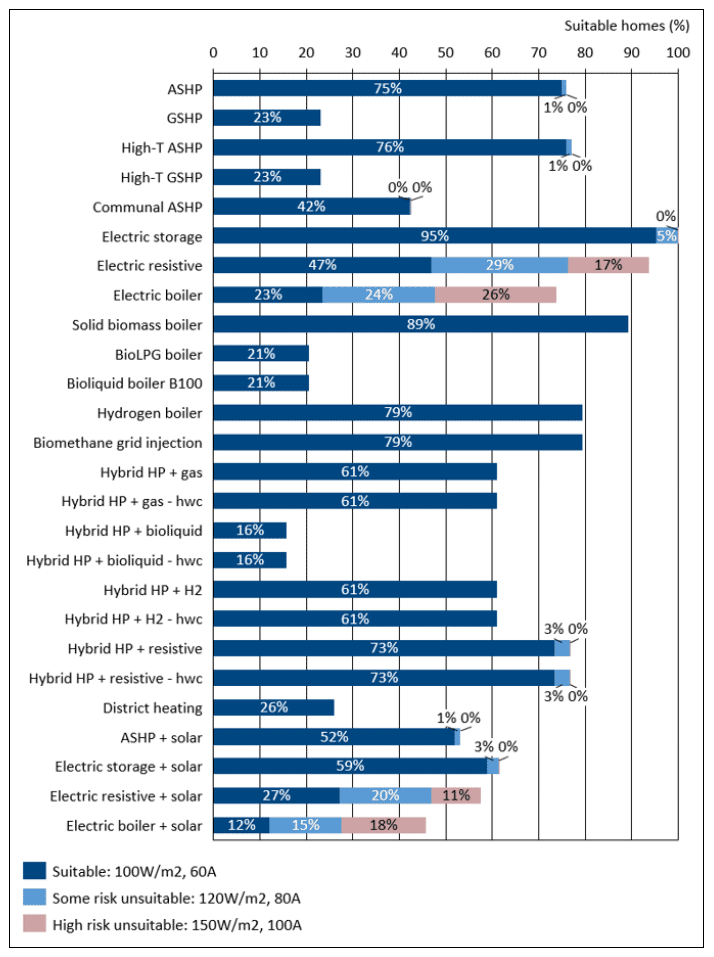
Figure description:
A horizontal bar chart shows the percentage of homes compatible with each technology under examination in 2040. The sensitivity of suitability was tested against three combinations of peak specific heat demand and fuse rating. The investigated technologies are air source and ground source heat pumps, high temperature air and ground source heat pumps, communal air source heat pumps, electric storage heating, direct electric heating, electric boiler, biomass and biofuel boilers, hydrogen boilers (both electrolysis and reforming), biomethane grid injection, hybrid heat pumps (with gas, gas and hot water cylinder, hydrogen, hydrogen and hot water cylinder, resistive heating, resistive and hot water cylinder) district heating, and heating technologies in combination with solar thermal (air source heat pump and solar, electric storage and solar, direct electric and solar and electric boiler and solar).
ASHP and high-temperature ASHP
The suitability of ASHP is predominantly determined by a combination of three constraints: space, fuse limit and peak specific heat demand. On the other hand, the suitability of high-temperature ASHP depends on two of these: space and fuse limit, but not peak specific heat demand.
The portion of the stock which is completely ruled out for ASHP and high-temperature ASHP is similar in 2017 and remains unchanged in 2040. These homes, amounting to ~24% of the overall stock, roughly correspond to the same fraction of the stock and are ruled out almost exclusively by the space constraint.
In fact, the energy efficiency upgrade measures considered in this study for bringing Scottish homes to EPC band C (or above) by 2040 are fabric measures that do not impact the space constraint. Therefore, these measures will not reduce the number of homes that are completely ruled out for ASHP and high-temperature ASHP.
The same measures, however, result in a general reduction in the heating demand of homes and therefore impact the peak specific heat demand constraint and the fuse limit constraint. In particular, fewer homes are affected by the specific heat demand constraint in 2040, resulting in significantly fewer homes for which the installation of an ASHP is associated with a risk of meeting thermal comfort.
In summary, while thermal comfort is at risk of not being met without appropriate energy efficiency fabric measures being carried out in some of the suitable homes with the installation of an ASHP in 2017, the installation of a high-temperature ASHP would ensure thermal comfort in homes where energy fabric measures or an upgrade to low-temperature wet system may not be feasible. While overall suitability of both technologies does not vary significantly in 2040 (which it is assumed by this work that energy efficiency fabric measures will have been carried out), the advantage of high-temperature ASHP over conventional ASHP is lost, as the reduced space heating demand allows for both technologies to meet thermal comfort equally.
GSHP and high-temperature GSHP
The suitability of GSHP and high-temperature GSHP is much lower than that of ASHP due to the additional requirements for the installation of a ground loop in a sufficiently large, accessible and geologically suitable plot. As the main constraints for these technologies are the space constraint and geological characteristics of the location, the suitability of both GSHP and high-temperature GSHP is similar and does not vary between 2017 and 2040, similar to the air-source technologies.
Communal ASHP
The suitability for communal ASHP is lower than that of individual ASHP due to additional constraint posed on the suitable dwelling type (with detached, semi-detached and end-terrace houses deemed unsuitable).
Electric resistive heating
While electric storage and direct electric heating are technically easy to implement in most homes, the relevance of the fuse limit constraint for these technologies is very important, due to their lower efficiency compared with that of heat pump technologies. This can be observed in the higher fragmentation into the three suitability risk categories. While very few homes are limited by fuse rating in the implementation of electric storage heating, a large portion is restricted for the installation of direct electric heating by the same constraint. This is due to the larger number of domestic appliances that are consuming electricity while direct electric heating is operating, thus reducing the amount of power that the heating devices can draw before exceeding the fuse limit. This also results in a larger share of suitable homes in 2040, due to a reduced space heating demand.
Similar considerations are also valid for electric boilers, which are operating during daytime and at an even lower efficiency than direct electric heating and are thus constrained by fuse limit in an even larger number of homes.
Bioenergy boilers
Solid biomass boilers, bioLPG boilers and bioliquid boilers are not suitable in all homes, due to the requirement of space for the volume of their storage/equipment. In addition, bioLPG boilers and bioliquid boilers are overall less suitable, as they were assumed to be only considered for homes that are located off the gas grid.
Low-carbon gas boilers
Hydrogen boilers and biomethane grid injection are assumed to be technically suitable in all buildings that are located on the gas grid. The validity of our assumption around the technical suitability of hydrogen boilers will need to be backed by further evidence, as the technical and safety case for hydrogen in the gas network and for the use for heating and in other gas using equipment is still being made, through relevant BEIS-led projects.
Hybrid heat pumps
The suitability for hybrid ASHP technologies is based on the combined suitability of its two main components: the ASHP and the additional heating source. The suitability of the ASHP component is evaluated applying the same constraints as for conventional ASHP but considering a lower peak heat demand, and compatibly with the reduced load delivered by the ASHP component in a hybrid system. The suitability of the additional source is evaluated considering that this technology will be the one supplying peak heat demand of a home, as it will be the only component operating on cold winter days.
Solar thermal
The suitability for systems including solar thermal collectors is based on the suitability of the main heating system component, with the additional requirement of the availability and appropriate orientation of a roof on which to secure the collectors.
4.4 Homes compatible with district heating
The characteristics of homes compatible with district heating were more closely analysed.
Figure 17 reports a comparison between the portion of the stock expected to be suitable and unsuitable for district heating. For both categories the number of homes as well as a breakdown of their age, property type, size, wall insulation, roof insulation and existing heating system are reported.
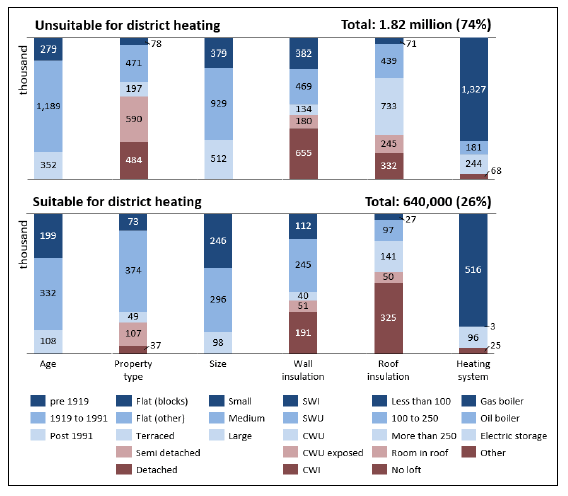
Figure description:
Two bar charts shows that 1.82 million Scottish homes (74% of total stock) are currently unsuitable for district heating and 640,000 homes (26% of total stock) are suitable for district heating based on a range of characteristics: age; property type; size; wall insulation; roof insulation; and heating system.
A comparatively smaller portion (26%) of Scottish homes are expected to be suitable for district heating. These are expected to be predominantly represented by flats (of any type) built between 1919 and 1991, with small area and uninsulated walls. This finding reflects the initial assumption of heat networks located in areas of high heat demand density, therefore often coinciding with densely populated areas where flats are a more common dwelling type.
The use of gas boilers is more widespread in homes suitable for district heating than in unsuitable homes (+8%). The reason for this is that homes suitable for district heating are also more likely to be located in areas supplied by the gas grid (87%) than the national average (79%). Figure 18 shows a breakdown of Scotland's housing stock according to the projected availability of district heating and the location on the gas grid.
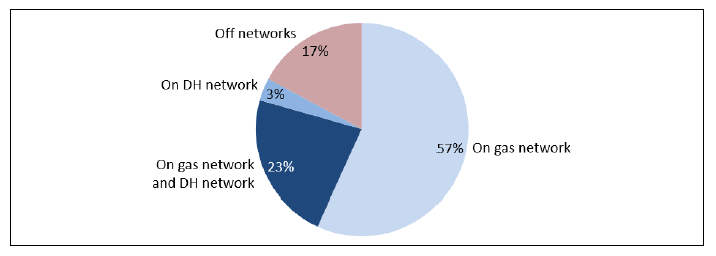
Figure description:
A pie chart shows the percentage of homes in Scotland based on the expected availability of district heating and connection to the gas network. It is found that 57% can be on gas network, 23% can be both on gas network and connect to a district heating network, 3% are connected to a district heating network, and 17% are off-gas network.
4.5 Dwellings with limited suitability
While many Scottish homes result to be suitable for a wide variety of low-carbon heating options, a significant share of homes is likely to be suitable only for a limited range of heating technologies. A restriction in the choice of heating system for a portion of the stock may carry some disadvantages and/or risks for the decarbonisation of domestic heating, especially if dwelling suitability is limited to expensive heating options or technologies that are not readily available. Most relevant risks are associated with following low-carbon heating technologies:
- Electric resistive heating: the reliance on electric resistive heating technologies for the decarbonisation of domestic heating might result in high costs. Included technologies are electric storage heating, direct electric heating, electric boilers and their respective combinations with solar thermal.
- Bioenergy: the implementation of low-carbon heating based on bioenergy relies on the future access to sufficient biomass feedstock and might therefore be subject to fuel availability uncertainty. Considered technologies are solid biomass boilers, bioLPG boilers, bioliquid boilers and hybrid heat pumps with bioliquid boilers as secondary source.
- Decarbonised gas grid: the availability of technologies that are supported by a decarbonised gas grid is tied to the future delivery of low carbon gas through the grid and might therefore be subject to implementation uncertainty. In fact, a strategic decision on the decarbonisation of the gas network through the supply of hydrogen will likely be based on the outcome of further studies on the technical suitability and safety of the use of hydrogen. Affected technologies are hydrogen boilers and hybrid heat pumps with hydrogen boilers as secondary source.
- District heating: similarly, the availability of district heating will predominantly depend on the scale of the development of heat networks and could therefore be subject to implementation uncertainty.
A less severe implementation risk may be associated with the adoption of heat pump technologies, as this would require measures to upgrade the electricity grid. When compared with the above discussed risks affecting other heating technologies, the implementation risk of the heat pump options is expected to be very mild, as a reinforcement of the electricity network is expected to be performed to also support the adoption of electric vehicles with domestic charging.
The extent to which Scotland's housing stock may be restricted in the implementation of low-carbon heating technologies was more closely investigated. Each of the technologies considered in this study was assigned to a technology group (see Table 9), characterised by the above-described risks. Homes that result from our analysis to be suitable for the installation of technologies from only a few of the technology groups are deemed as most "at risk".
| Heat pumps | District heating | Decarbonised gas | Electric resistive | Bioenergy |
|---|---|---|---|---|
|
|
|
|
|
| Lower risk | Higher risk | |||
Note that the actual number of Scottish homes for which a future implementation of low-carbon heating technologies could be problematic or not feasible may be higher than the figures provided by our analysis, due to the limited extent of constraints and obstacles included in our initial assumptions.
Based on the assumptions of this study, results suggest that all Scottish homes could have at least one of the investigated technologies applied. Additionally, the majority of homes result to be suitable for at least one of the lower-risk technologies of the "heat pump" group, accounting for ~81.3% of the stock when considering fuse limit of 80A and peak specific heating demand of 120 W/m2 in 2040.
The remaining stock is therefore limited to the implementation of heating technologies from the higher-risk categories, and accounts for 18.7% of the stock for thresholds of 80A and 120 W/m2 in 2040 but is expected to comprise 19.3% of the stock for thresholds of 60A and 100 W/m2 in 2040.
The portion of the stock resulting unsuitable for heat pump technologies in 2040 is reported in Table 10, broken down into 16 categories with various combinations of technology choice restriction (and therefore various degrees of combined risk). The reported figures on the right refer to the portion of homes that can choose from all groups indicated in the respective row on the left at the same time. Sufficient condition for the suitability for a technology group is the suitability for at least one of the included technologies (e.g. homes suitable for bioLPG boilers are considered suitable for the "Bioenergy" group).
| Suitable technologies for homes with restricted choice | Homes with restricted choice | % of stock | ||||
|---|---|---|---|---|---|---|
| 1 | District heating | Decarb. gas | Electric resistive | Bioenergy | 20,000 | 0.8% |
| 2 | District heating | Decarb. gas | Electric resistive | - | 112,000 | 4.5% |
| 3 | District heating | Decarb. gas | - | Bioenergy | 1 | 0% |
| 4 | District heating | Decarb. gas | - | - | 40 | 0% |
| 5 | District heating | - | Electric resistive | Bioenergy | 22,000 | 0.9% |
| 6 | District heating | - | Electric resistive | - | 0 | 0% |
| 7 | District heating | - | - | Bioenergy | 70 | 0% |
| 8 | District heating | - | - | - | 0 | 0% |
| 9 | - | Decarb. gas | Electric resistive | Bioenergy | 136,000 | 5.5% |
| 10 | - | Decarb. gas | Electric resistive | - | 90,000 | 3.6% |
| 11 | - | Decarb. gas | - | Bioenergy | 60 | 0% |
| 12 | - | Decarb. gas | - | - | 60 | 0% |
| 13 | - | - | Electric resistive | Bioenergy | 78,000 | 3.2% |
| 14 | - | - | Electric resistive | - | 0 | 0% |
| 15 | - | - | - | Bioenergy | 1,200 | 0.05% |
| 16 | - | - | - | - | 0 | 0% |
| Total | 459,000 | 18.7% | ||||
No homes in the Scottish housing stock are restricted in their technology choice to district heating only (see row 8 in Table 10) or electric resistive heating only (row 14), and less than 100 are restricted to decarbonised gas technologies only (row 12).
However, a more consistent number of homes are restricted to choosing from technologies in the bioenergy group only (row 15) or from other technologies deemed "at risk".
Four combinations in particular are identified as most at risk, due to their restricted selection of suitable technologies and the relatively large number of affected homes:
- Row 9: 136,000 homes that must choose among decarbonised gas, electric resistive and bioenergy technology groups only. These homes are potentially at risk of incurring in high costs (electricity) or the uncertain availability of the selected technology (decarbonised gas and bioenergy).
- Row 10: 90,000 homes that must choose between decarbonised gas and electric resistive technology groups only. These homes are potentially at risk of incurring in high running costs (electricity) or the uncertain availability of the selected technology (decarbonised gas).
- Row 13: 78,000 homes that must choose between electric resistive and bioenergy technology groups only. These homes are potentially at risk of incurring in high running costs (electricity) or the uncertain availability of the selected technology (bioenergy).
- Row 15: 1,200 homes that can only choose bioenergy technology group only. These homes are potentially at risk of uncertain availability of the selected technology.
Figure 19 reports the number of homes estimated to be comprised under these categories in 2040, considering a range of values of peak specific heat demand and fuse rating as utilised in the previous suitability analysis (see sections 4.1.3 and 4.1.4). The four assessed categories are placed in order of implementation risk, with lower risk on the left and higher risk on the right.
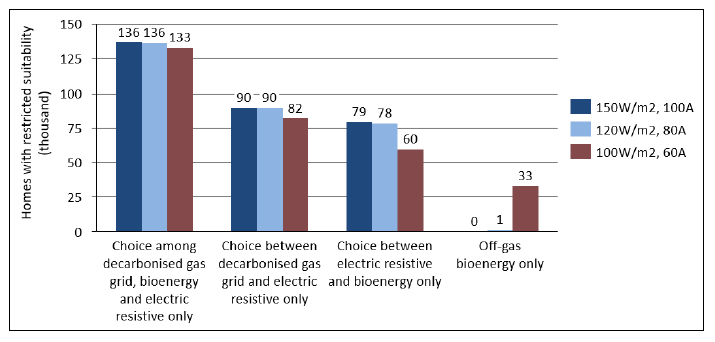
Figure description:
A bar chart shows the number of homes that are expected to have restricted suitability of heating options. The breakdown is done according to: homes with a choice among decarbonised gas grid, bioenergy and electric resistive only; homes with a choice between decarbonised gas grid and electric resistive only; homes with the choice between electric resistive and bioenergy only; and homes with the option of off-gas bioenergy only. The sensitivity of suitability was tested against three combinations of peak specific heat demand and fuse rating.
Note that higher thresholds of peak specific heat demand, measured in W/m2, increase the suitability of heat pump technologies, whereas high values of fuse limit, measured in Ampere, increase the suitability of electric resistive heating technologies. However, given how little the suitability of heat pump technologies is expected to vary depending on the peak specific heat demand threshold in 2040, it is appropriate to assume that the number of homes in each category depends almost exclusively on the chosen value of fuse limit.
While each of the four investigated combinations represents a portion of the stock which is highly dependent on the specific heat demand and fuse limit thresholds considered, these are never exceeding 150,000 homes or 6% of the total stock each.
The number of homes included in the first three categories on the left in Figure 19 (corresponding to rows 9, 10 and 13 in Table 10) is smaller for smaller values of fuse limit, as these three categories are defined by the suitability also for electric resistive heating. In fact, a lower fuse limit threshold corresponds to a smaller number of homes suitable for the installation of electric resistive heating technologies.
Conversely, the number of homes included in the last category on the right in Figure 19 (corresponding to row 15 in Table 10) is larger for smaller values of fuse limit and peak specific heat demand. In fact, low fuse limit values correspond to fewer homes resulting to be suitable for electric resistive heating. Therefore, a portion of homes that for higher fuse limit threshold values would fit into the "electric resistive and bioenergy" category (row 13) for low fuse limit values, fall into the "bioenergy only" category (row 15) and add up to the number of homes that would fall into the "bioenergy only" category also with higher values of fuse limit. Additionally, a smaller value of peak specific heat demand results in a larger number of homes unsuitable for the installation of heat pump technologies, which may also contribute to populate the category "bioenergy only" (row 15). The contribution of the varying peak specific heat demand threshold is, however, much smaller than that of the fuse limit.
Categories in rows 1-8 in Table 10 correspond to the same combinations of categories in rows 9-16, with the additional requisite of the suitability for district heating. While the main concerns around restricted technology suitability regard categories in rows 9-16, in the event that district heating networks in Scotland would not develop to the expected capacity, those homes in categories in rows 1-8 would need to be added to the count of homes in categories in rows 9-16.
A similar assessment was therefore performed on homes belonging to the categories in rows 1,2, 5 and 7, corresponding to the above analysed categories 9, 10, 13 and 15 but with the addition of the suitability for district heating. The results of this analysis are reported in Figure 20.
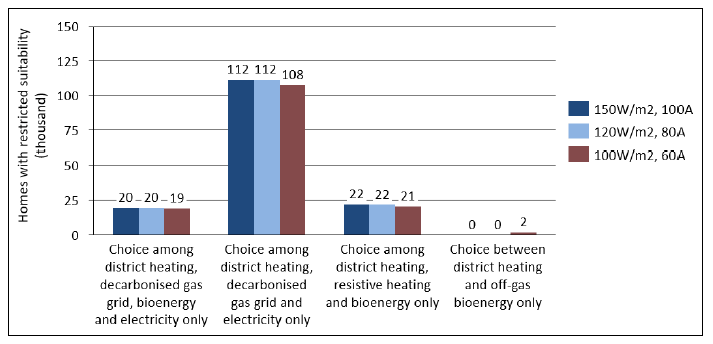
Figure description:
A bar chart shows the number of homes that are expected to have restricted suitability of heating options including district heating. The breakdown is done according to: homes with a choice among district heating, decarbonised gas grid, bioenergy and electric resistive only; homes with a choice among district heating, decarbonised gas grid and electric resistive only; homes with the choice among district heating, electric resistive and bioenergy only; and homes with the choice between district heating and off-gas bioenergy only. The sensitivity of suitability was tested against three combinations of peak specific heat demand and fuse rating.
If district heating were not implemented, the number of homes included in the four above mentioned categories at risk (rows 9, 10, 13 and 15) would increase in total by roughly 50%. As homes that would have been suitable for district heating are generally located in urban areas, they will generally be dwellings that are smaller in size and less exposed to the weather. Their energy demand would thus be relatively low, increasing their suitability for electric resistive heating technologies. Additionally, location in an urban area is also generally associated with location in an area supplied by the gas grid. As a consequence, if district heating were not implemented, the number of homes included in four above mentioned categories at risk would generally increase, with the largest increase expected for the second category, i.e. homes suitable for decarbonised gas and electricity only.
The bioenergy demand of Scottish homes was estimated for the two portions of the stock associated with the categories "electric resistive and bioenergy only" (row 13) and for "bioenergy only" (row 15). The fuel demand was estimated assuming that all homes in both categories would install a bioenergy-based heating technology. The results are reported in Figure 21, showing different fuel demands depending on the type of biofuel used (biomass, bioLPG or bioliquid B100) and for a range of peak specific heat demand and fuse limit.
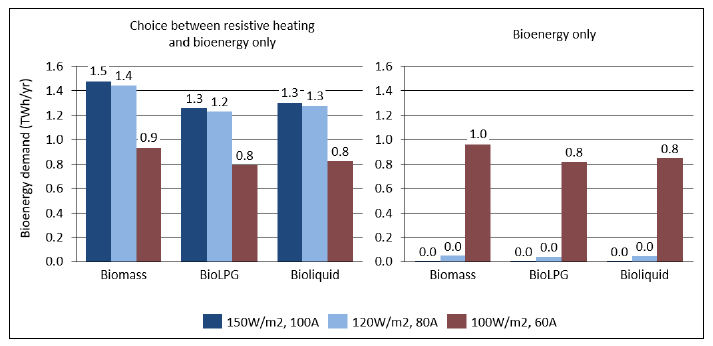
Figure description:
Two bar charts show the projected bioenergy demand in 2040 for homes with the choice between resistive heating and bioenergy only and homes with the option of bioenergy only. Demand is broken down into three fuel options which are biomass, Bio-LGP and Bioliquid. The sensitivity of suitability was tested against three combinations of peak specific heat demand and fuse rating.
Due to the different efficiency of the various bioenergy-based heating technologies, a slightly different fuel demand is associated with the use of each fuel type, while delivering the same amount of heat. The variations related to the values of peak specific heating demand and fuse limit are due to the change in the number of homes that are limited to installing a bioenergy-based heating technology.
Total bioenergy demand from both categories is lower than 2 TWh/yr for all considered values of peak specific heating demand and fuse limit. For comparison, the current bioenergy availability in the UK was well over 100 TWh/yr in 2014[33] and is likely to lie between 130 and 350 TWh/yr in 2050.[34]
When considering peak specific heat demand of 100W/m2 and fuse limit of 60A, total fuel demand of both categories amounts to 630,000 tonnes of biomass, 230,000 litres of bioLPG and 200 litres of bioliquid B100.[35]
A breakdown of the age, property type, size and existing heating system of the portion of the stock belonging to the most relevant four categories of homes with limited technology choice (corresponding to rows 9, 10, 13 and 15 in Table 10) is reported in Figure 22. For a comparison with the characteristics of the entire Scottish housing stock, see Figure 1.
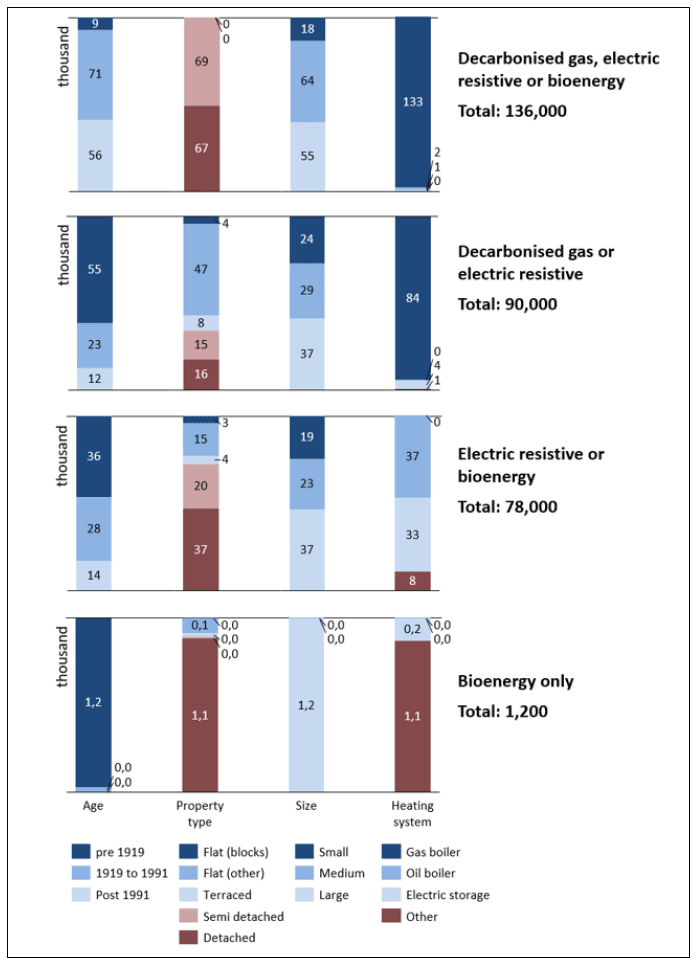
Figure description:
Four bar charts shows that in 2040, 136,000 homes will have a choice among decarbonised gas grid, bioenergy and electric resistive only, 90,000 homes will have a choice between decarbonised gas grid and electric resistive only, 78,000 homes with the choice between electric resistive and bioenergy only, and 1,200 homes will only have the option of off-gas bioenergy. The breakdown is based on fuse limit of 80 A and peak specific heating demand of 120 W/m2 and 4 building characteristics, which are age, property type, size and heating system.
The first category "decarbonised gas grid, bioenergy or electricity only" (corresponding to row 9 in Table 10) includes a larger portion of new homes built after 1991 (+23%) and a larger share of detached and semi-detached homes (+50%) than the national distribution. These homes also report more often a large floor area over 108 m2 (+15%). Homes falling within this category are mostly new homes that are not suitable for heat pump technologies due to the lack of space for the installation of the system's equipment.
The category "decarbonised gas grid or electricity only" (corresponding to row 10 in Table 10) reports more older homes than the national distribution (+42%), more flats (+16%) and fewer detached or semi-detached homes (-15%). Homes in this category are likely located in urban areas, where they are more likely to be located close to the gas network. Furthermore, urban areas present more flats and fewer detached homes than the national average, and have therefore on average a smaller heating demand and smaller area. Therefore, heating demand is likely to be low enough to accommodate electric resistive heating without exceeding the fuse rating, but will also not offer sufficient space for the installation of heat pumps.
In the category "electric resistive or bioenergy" (corresponding to row 13 in Table 10) there is a large share of older homes built before 1919 (+27%), detached homes (+26%) and large homes with floor area over 108 m2 (+22%). This category describes homes located away from the gas grid, that are sufficiently well insulated to allow for the installation of electric resistive heating but cannot install heat pump technologies due to space constraints.
Finally, the last category "off-gas bioenergy only" (corresponding to row 15 in Table 10) presents a distribution of characteristics that favour large, old, detached houses. These are large individual homes located away from the gas grid with a large heating demand that precludes the installation of both heat pump technologies and electric resistive heating technologies.
Contact
Email: zeroemissionsheat@gov.scot
There is a problem
Thanks for your feedback